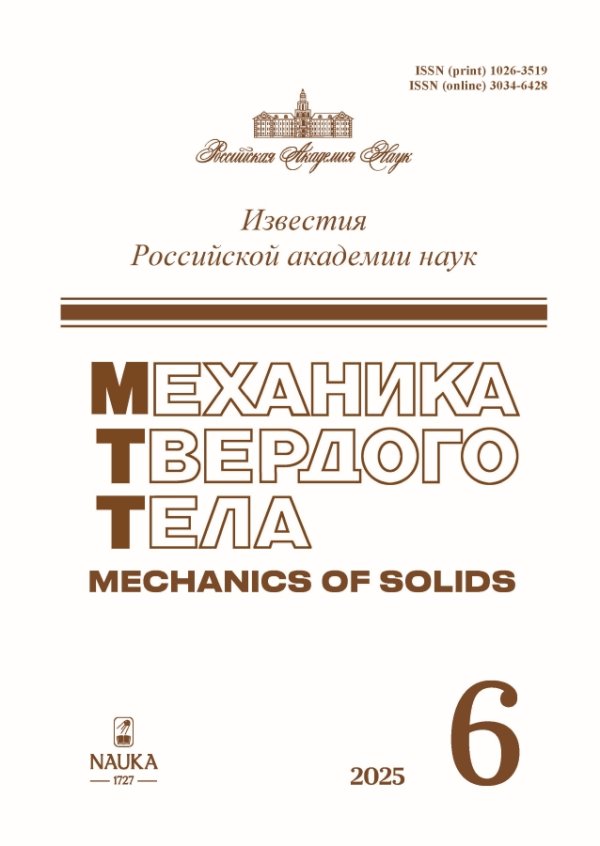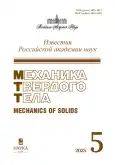The elastic constants of an isotropic medium can have arbitrary values
- Authors: Ostrosablin N.I.1
-
Affiliations:
- Institute of Hydrodynamics named after M.A. Lavrentiev, Siberian Branch of the Russian Academy of Sciences
- Issue: No 5 (2025)
- Pages: 49-70
- Section: Articles
- URL: https://medbiosci.ru/1026-3519/article/view/315573
- DOI: https://doi.org/10.31857/S1026351925050037
- EDN: https://elibrary.ru/bvcmno
- ID: 315573
Cite item
Abstract
Using the example of the matrix of elastic constants of an isotropic material, it is shown that the Young’s modulus, shear modulus, volume modulus, and Poisson’s ratio can take any real values. In this case, the positive definiteness of the matrix of elastic constants is not mandatory, as is traditionally assumed. The positivity of the specific strain energy also occurs when the matrix of elastic constants is not positive definite. It is sufficient for the invertibility of the relations of Hooke’s law to require the non-degeneracy of the matrix of elasticity constants. Graphs of Young’s modules, volume and Poisson’s ratio depending on the ratio of Lame constants are given.
About the authors
N. I. Ostrosablin
Institute of Hydrodynamics named after M.A. Lavrentiev, Siberian Branch of the Russian Academy of Sciences
Author for correspondence.
Email: o.n.ii@yandex.ru
Novosibirsk, Russia
References
- Boulanger P., Hayes M. On Young’s modulus for anisotropic media // Trans. ASME. J. Appl. Mech. 1995. V. 62. № 3. P. 819820. https://doi.org/10.1115/1.2897022
- Boulanger P., Hayes M. Poisson’ ratio for orthorhombic materials // J. Elast. 1998. V. 50. № 1. P. 8789. https://doi.org/10.1023/A:1007468812050
- Cazzani A., Rovati M. Extrema of Young’s modulus for cubic and transversely isotropic solids // Intern. J. Solids Struct. 2003. V. 40. № 7. P. 17131744. https://doi.org/10.1016/S0020-7683(02)00668-6
- Ting T.C.T. The stationary values of Young’s modulus for monoclinic and triclinic materials // J. Mech. 2005. V. 21. № 4. P. 249253. https://doi.org/10.1017/S1727719100000691
- Ting T.C.T. Explicit expression of the stationary values of Young’s modulus and the shear modulus for anisotropic elastic materials // J. Mech. 2005. V. 21. № 4. P. 255266. https://doi.org/10.1017/S1727719100000708
- Norris A.N. Extreme values of Poisson’s ratio and other engineering moduli in anisotropic materials // J. Mech. Mater. Struct. 2006. V. 1. № 4. P. 793812. https://doi.org/10.2140/jomms.2006.1.793
- Norris A.N. Poisson’s ratio in cubic materials // Proc. Roy. Soc. London. Ser. A. 2006. V. 462. № 2075. P. 33853405. https://doi.org/10.1098/rspa.2006.1726
- Hayes M., Shuvalov A. On the extreme values of Young’s modulus, the shear modulus, and Poisson’s ratio for cubic materials // Trans. ASME. J. Appl. Mech. 1998. V. 65. № 3. P. 786787. https://doi.org/10.1115/1.2789130
- Ting T.C.T. Very large Poisson’s ratio with a bounded transverse strain in anisotropic elastic materials // J. Elast. 2004. V. 77. № 2. P. 163176. https://doi.org/10.1007/s10659-005-2156-6
- Ting T.C.T., Chen T. Poisson’s ratio for anisotropic elastic materials can have no bounds // Quart. J. Mech. Appl. Math. 2005. V. 58. № 1. P. 7382. https://doi.org/10.1093/qjmamj/hbh021
- Tarumi R., Ledbetter H., Shibutani Y. Some remarks on the range of Poisson’s ratio in isotropic linear elasticity // Philosophical Magazine. 2012. V. 92. № 10. P. 12871299. https://doi.org/10.1080/14786435.2011.644816
- Lisovenko D.S. Anomal’nye velichiny koephphitsienta Puassona anizotropnykh kristallov [Anomalous values of Poisson’s ratio of anisotropic crystals] // Deformatsiya i razrusheniye materialov. 2011. № 7. p. 110 (In Russian).
- Epishin A.I., Lisovenko D.S. Extreme values of the Poisson’s ratio of cubic crystals // Technical Physics. 2016. V. 61. P. 15161524. https://doi.org/10.1134/S1063784216100121
- Ostrosablin N.I. Extreme conditions of elastic constants and principal axes of anisotropy. J. Appl. Mech. Tech. Phy. 2016. V. 57. P. 740756. https://doi.org/10.1134/S0021894416040192
- Ostrosablin N.I. O naitesneyshikh granitsakh konstant uprugosti i privedenii udel’noy energii deformatsii k kanonicheskomu vidu [On the most restrictive bounds on elastic constants and the reduction of speci c deformation energy to canonical form] // Izvestiya AN SSSR. Mekhanika tvyordogo tela. 1989. № 2. P. 9094 (In Russian).
- Ostrosablin N.I. The most restrictive bounds on change in the applied elastic constants for anisotropic materials. J. Appl. Mech. Tech. Phys. 1992. V. 33. P. 95101. https://doi.org/10.1007/BF00864513
- Annin B.D., Ostrosablin N.I. Anisotropy of elastic properties of materials. J. Appl. Mech. Tech. Phys. 2008. V. 49. P. 998 1014. https://doi.org/10.1007/s10808-008-0124-1
- Truesdell C. A first course in rational continuum mechanics // The John Hopkins University. Baltimore, Maryland. 1972.
- Ostrosablin N.I. Symmetry classes of the anisotropy tensors of quasielastic materials and a generalized Kelvin approach. J. Appl. Mech. Tech. Phys. 2017. V. 58. P. 469–488. https://doi.org/10.1134/S0021894417030129
- Ostrosablin N.I. Sobstvennye moduli uprugosti i sostoyaniya dlya materialov kristallographicheskikh singoniy [Elasticity eigenvalues and eigenvectors for the materials of crystallographic singonium]. Novosibirsk: Dinamika sploshnoy sredy. 1986. V. 75. P. 113125 (In Russian).
- Lurie A.I. Theory of elasticity. Springer Science; Business Media, 2010.
- Chernyshev G.N. Mutual generalization of elastic and gravitational eld equations on the basis of solid mechanics. Mech. Solids, 2002. V. 37. № 2. P. 7081.
- Chernyshev G.N. Uprugost’, gravitatsiya, elektrodinamika [Elasticity, gravity, electrodynamics]. Moscow: Nauka, 2003. 144 p. (In Russian).
- Bukreeva K.A., Babicheva R.I., Dmitriev S.V. et al. Negative sti ness of the FeAl intermetallic nano lm // Phys. Solid State. 2013. V. 55. P. 19631967. https://doi.org/10.1134/S1063783413090072
- Lakes R., Wojciechowski K.W. Negative compressibility, negative Poisson’s ratio, and stability // Physica Status Solidi. B. 2008. V. 245. № 3. P. 545551. https://doi.org/10.1002/pssb.200777708
- Wu Y., Lai Y., Zhang Z.-Q. Elastic metamaterials with simultaneously negative e active shear modulus and mass density // Physical Review Letters. 2011. V. 107. № 10. P. 105506–1105506-5. https://doi.org/10.1103/PhysRevLett.107.105506
- Zadpoor A.A. Mechanical meta-materials // Materials Horizons. 2016. V. 3. № 5. P. 371381. https://doi.org/10.1039/C6MH00065G
- Yu X., Zhou J., Liang H. et al. Mechanical metamaterials associated with stiffness, rigidity and compressibility. A brief review // Progress in Materials Science. 2018. V. 94. P. 114173. https://doi.org/10.1016/j.pmatsci.2017.12.003
- Ostrosablin N.I. Uniqueness of the Solution of Boundary Value Problems for the Static Equations of Elasticity Theory with a Nonsymmetric Matrix of Elastic Moduli. J. Appl. Ind. Math. 2022. V. 16. P. 713719. https://doi.org/10.1134/S1990478922040123
- Cairns A.B., Catafesta J., Levelut C. et al. Giant negative linear compressibility in zinc dicyanoaurate // Nat. Mater. 2013. V. 12. P. 212216. https://doi.org/10.1038/nmat3551
- Ostrosablin N.I. Functional relation between two symmetric second-rank tensors // J. Appl. Mech. Tech. Phys. 2007. V. 48. P. 734–736. https://doi.org/10.1007/s10808-007-0094-8
- Ostrosablin N.I. Funktsii kineticheskikh napryazheniy v mekhanike sploshnykh sred [Functions of kinetic stresses in the mechanics of continuous media]. Novosibirsk: Dinamika sploshnoy sredy, 2007. V. 125. P. 76116 (In Russian).
- Pipkin A.C. Constraints in linearly elastic materials // J. Elast. 1976. V. 6. № 2. P. 179–193. https://doi.org/10.1007/BF00041785
- Goldshtein R.V., Gorodtsov V.A., Lisovenko D.S. Modul’ sdviga kubicheskikh kristallov [Shear modulus of cubic crystals] // Pisma o materialakh. 2012. V. 2. № 1. P. 21–24 (in Russian). https://doi.org/10.22226/2410-3535-2012-1-21-24
- Goldstein R.V., Gorodtsov V.A., Komarova M.A., Lisovenko D.S. Extreme values of the shear modulus for hexagonal crystals // Scripta Materialia. 2017. V. 140. P. 55–58. https://doi.org/10.1016/j.scriptamat.2017.07.002
- Gorodtsov V.A., Lisovenko D.S. Extreme values of Young’s modulus and Poisson’s ratio of hexagonal crystals // Mechanics of Materials. 2019. V. 134. P. 1–8. https://doi.org/10.1016/j.mechmat.2019.03.017
- Gorodtsov V.A., Lisovenko D.S. Auksetiki sredi materialov s kubicheskoi anizotropiey [Auxetics among materials with cubic anisotropy] // Izvestiya RAN. Mekhanika tvyordogo tela. 2020. № 4. P. 7–24 (in Russian). https://doi.org/10.31857/S0572329920040054
- Gorodtsov V.A., Tkachenko V.G., Lisovenko D.S. Extreme values of Young’s modulus of tetragonal crystals // Mechanics of Materials. 2021. V. 154. P. 103724. https://doi.org/10.1016/j.mechmat.2020.103724
- Gorodtsov V.A., Lisovenko D.S. The extreme values of Young’s modulus and the negative Poisson’s ratios of rhombic crystals // Crystals. 2021. V. 11. № 8. P. 863. https://doi.org/10.3390/cryst11080863
- Volkov M.A. Stationary Points of Poisson’s Ratio of Six-Constant Tetragonal Crystals AT Particular Orientations // Mech. Solids. 2024. V. 59. P. 3254–3265. https://doi.org/10.1134/S0025654424606244
Supplementary files










